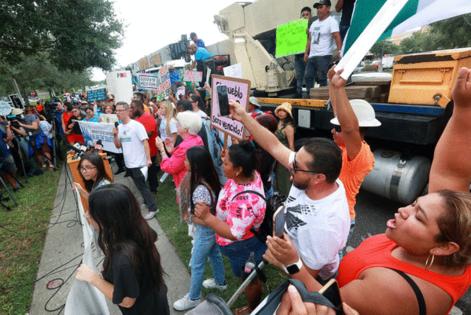Florida eyes 2nd immigration detention center to join 'Alligator Alcatraz'
Published in News & Features
ORLANDO, Fla. — Florida and federal officials plan to set up as many as 5,000 immigration detention beds as soon as next week at an Everglades airfield nicknamed “Alligator Alcatraz” and potentially at a National Guard training base in the northern part of the state.
Gov. Ron DeSantis said Wednesday the state-run detention centers will relieve county jails facing an influx of inmates subject to deportation. Florida officials have vowed to aggressively support President Donald Trump’s immigration crackdown.
“It’ll be a force multiplier,” DeSantis said in Tampa. “It’ll help DHS (Department of Homeland Security). It’ll help our state and local law enforcement with relieving some burden on resources.”
DeSantis used emergency powers earlier this week to seize a Miami-Dade County-owned airfield for a detention center dubbed “Alligator Alcatraz,” a move that outraged Democrats and prompted environmental concerns given its location in the Everglades, a place Florida and and the federal government have spent billions of dollars trying to restore.
The state also is looking at Camp Blanding, a Florida National Guard training center located southwest of Jacksonville, for use as another detention center, the governor said.
DeSantis deemed illegal immigration to be an emergency in 2023, giving himself more leeway to use state and local resources.
Florida Attorney General James Uthmeier touted the planned Everglades facility as “the one-stop shop to carry out President Trump’s mass deportation agenda,” adding that any escapee would face alligators and pythons in the surrounding wetlands.
It will cost $245 per day per bed to house detainees, or about $450 million a year, according to a U.S. official. Florida can request reimbursement from the Federal Emergency Management Agency. FEMA has about $625 million available in its shelter and services program for the effort, federal officials said.
Officials have described the centers as temporary with “heavy-duty” tents and trailers. Facility workers are to be housed in old FEMA trailers. National guard officials are to help run the facilities.
Detainees would include people arrested under the 287(g) program, which allows local and state law enforcement to help enforce federal immigration law. U.S. Immigration and Customs Enforcement will also be able to transfer detainees to Florida’s custody.
Central Florida officials have expressed concerns that a spike in immigration-related arrests could max out jails. On Wednesday morning, 3,111 people were housed in the Orange County Jail, which has a capacity of about 4,000 beds. There were 238 inmates with an ICE detainer.
Immigration arrests have surged in Central Florida since Trump’s return to office. In all of 2024, for example, Orange booked about 800 people on ICE detainers into its jail. By the end of May, the 2025 count had already hit 1,314.
The Everglades project has gotten pushback from environmentalists, the Miccosukee Tribe and Democrats, including Miami-Dade County Mayor Daniella Levine Cava. Conservationists worry the project could damage the Everglades. Miccosukee Tribe of Florida chairman Talbert Cypress said he opposes the use of the tribe’s “ancestral lands” for a detention center.
U.S. Rep. Maxwell Alejandro Frost blasted the Alligator Alcatraz proposal in a statement, saying it puts “cruelty and spectacle” over people.
“They target migrants, rip families apart, and subject people to conditions that amount to physical and psychological torture in facilities that can only be described as hell on Earth,” the Orlando Democrat said. “Now, they want to erect tents in the blazing Everglades sun and call it immigration enforcement.”
DeSantis dismissed environmental concerns, saying there will be “zero” impact.
“They’re trying to use the Everglades as a pretext just for the fact that they oppose immigration enforcement,” he said. “That’s where you are on the far-left now.”
Last month, Florida officials submitted a 37-page immigration enforcement plan to the federal government that called for detention centers in the south-central and northeastern regions of the state capable of holding 10,000 people.
The potential locations would mostly be near airstrips to “support a seamless detention and deportation process,” according to the plan.
_______
©2025 Orlando Sentinel. Visit orlandosentinel.com. Distributed by Tribune Content Agency, LLC.







Comments